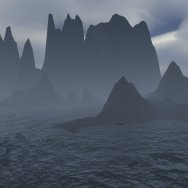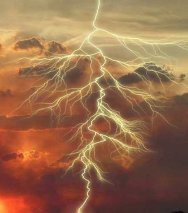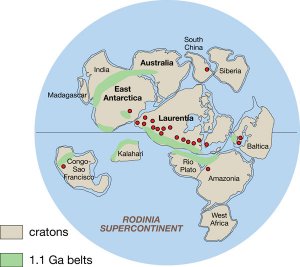Precambrian Time Geological History
Geological History of Precambrian Time(4500 to 541 mya) |
Also see: Precambrian Time Paleobiology | |||
|
Preface - about the Sea
The sea was the mother of all life beginning some 3.8 billion years ago, and remains so today. The land-based animals each carry with them a miniature ocean, pulsing in their cells and circulatory systems. All life, including human, could be viewed as containers of sea water with the same mineral constituency as the oceans, and a dynamic dispersion of molecules that perform the biological processes that constitute life. In
all living cells - proteins answer for both form and function.
Proteins are the active elements of cells that aid and control
the chemical reactions that make the cell work. They receive signals
from outside of the cell. They control the processes by which
proteins are made from the instructions in the genes. They also
form the scaffolding that gives cells their shape and as well
as parts of the linkages that stick cells together into tissues
and organs. A protein's shape determines its function, which,
in turn, depends on its water-hating (hydrophobic) properties
- to perform their biological functions, proteins must be immersed
in a miniature sea within the cell that does not greatly differ
from the sea from whence it came. Life came from the sea, and
the sea sustains life. The Hadean is the geological time period during which Earth formed, from the start of the solar system (4.6 billion years ago) until accretion, impact, and local melting led to stable Earth-Moon orbits and the oldest Earth rocks (3.8 billion years ago). It is believed that the earth formed 15 billion years after the Big Bang, and some 4 ½ billion years ago, a time span beyond comprehension. It was some 4 billion years afterwards that animals for the first time left their mark in the fossil record. It was during this Precambrian period when profound events occurred, leading ultimately to "life" as we know it today. From 4.5 to 3.8 bya (the Hadean) the earth was indeed a hellish (as the name Hadean means, hostile place. During this period the sun formed by gravitational compaction, and eventually reached temperature and pressure conditions for nuclear fusion. Other particles coalesced under gravity to form continually growing planets. The oldest rocks on earth (3.8 bya) were formed through the cooling of the theretofore, molten Earth. Archaean Time (3800 to 2500 mya) During the period between 3.8 and 2.5 bya, the Earth's atmosphere comprised methane, ammonia, and other gases which would be toxic to most life on our planet today. The Earth's crust continued to cool, and rocks and continental plates began to form. It is thought that life first formed during this period. The oldest known fossils are bacterial microfossils that roughly date to 3.5 billion years ago. Proterozoic
Era (2500 to 544 mya) The lack of fossils of hard-shelled organisms in the Precambrian makes determination of paleo-geography of the earth essentially impossible prior to about 650 MA. What is known supports the theory of the formation of the oldest supercontinent, Rodinia some 1.1 BA, and its subsequent breakup into two halves beginning at about 750 MA, forming the Panthallassic Ocean. The Upper Proterozoic earth is thought to have been an ice-house, similar to present-day earth. North America is thought to have formed the center of Rodinia, with the east coast of North America adjacent to western South America and the west coast of North America adjacent to Australia and Antarctica. In the breakup, North America rotated southwards towards the South Pole. The northern half of Rodinia comprising Antarctica, Australia, India, and the what would ultimately become China rotated counter-clockwise and north across the North Pole. The components that formed the late Paleozoic continents of Pangea (Laurasia and Gondwana) were evolving during the Upper Proterozoic. A third continent called the Congo craton lay between the two halves of Rodinia and comprised what is now north-central Africa. Near the end of the Proterozoic, the three continents collided to form a new supercontinent called Pannotia, resulting in the Pan-African orogeny (i.e., mountain building event). Pannotia, in turn, began to break apart at about 600 million years ago. Evidence
suggests that glaciers were more extensive on earth during the
late Precambrian than at any other time in geological history,
with much of the earth's land mass located at either pole.
| ||||
Fossil
Museum Navigation:
Home Geological Time Paleobiology Geological History Tree of Life Fossil Sites Fossils Evolution Fossil Record Museum Fossils |

 Any
consideration of the geological history of earth as it pertains to the genesis
and evolution of life, that is, to paleobiology, must hold the sea as centric.
Life began in the sea, and most extant life yet exists in the sea. The sea contains
an incomprehensible diversity of life, mostly still undiscovered or described,
ranging across all the domains of life. The sea is absolutely brimming with microscopic
life, including bacteria that make their living by a constellation of different
metabolic processes, and the Archaeans, among which are the extremophiles living
in vents at temperatures well above the boiling point of water.
Any
consideration of the geological history of earth as it pertains to the genesis
and evolution of life, that is, to paleobiology, must hold the sea as centric.
Life began in the sea, and most extant life yet exists in the sea. The sea contains
an incomprehensible diversity of life, mostly still undiscovered or described,
ranging across all the domains of life. The sea is absolutely brimming with microscopic
life, including bacteria that make their living by a constellation of different
metabolic processes, and the Archaeans, among which are the extremophiles living
in vents at temperatures well above the boiling point of water. 
